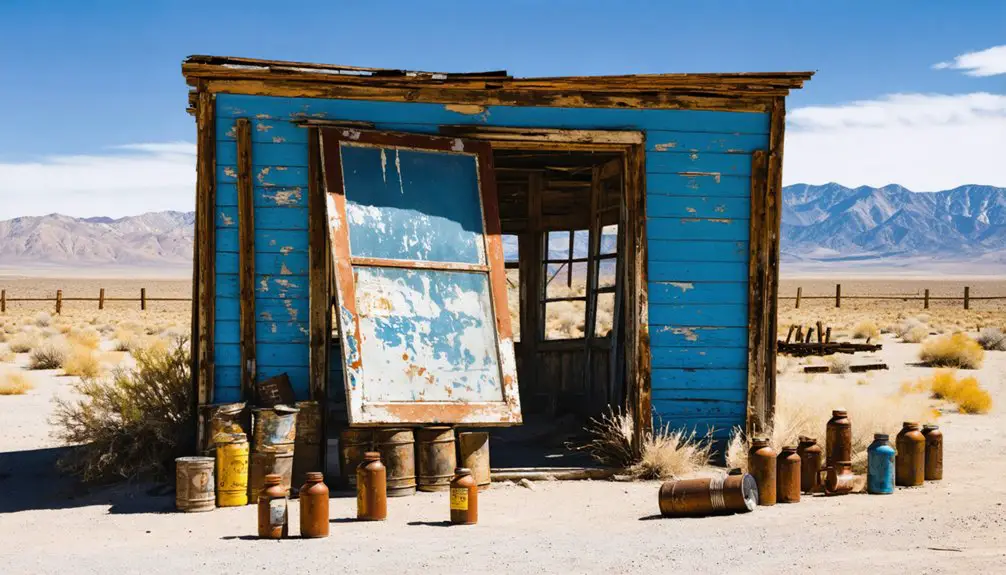You’ll find Etna’s abandoned ruins in Pershing County, Nevada, where two bustling silver ore mills once powered this frontier settlement. Established in 1865, the town quickly grew around its milling operations, supporting nearly 500 residents with a hotel, general store, and ferry service. Despite innovations in milling techniques, toxic antimony fumes and harsh working conditions led to Etna’s swift decline by late 1866. The site’s contaminated remnants tell a cautionary tale of Nevada’s silver rush era.
Key Takeaways
- Founded in 1865 as a silver ore milling settlement, Etna briefly flourished with two productive mills processing ore from nearby mining districts.
- The town reached a peak population of 500 residents before rapidly declining due to mill closures and toxic antimony contamination.
- Etna’s post office operated only briefly in 1866, signaling the swift transformation from bustling mill town to abandoned settlement.
- Workers faced severe health risks from antimony fumes and mercury exposure while processing silver ore in harsh desert conditions.
- The site’s legacy includes ongoing environmental contamination from antimony, mercury, and lead, affecting the surrounding ecosystem and visitors.
The Birth of a Milling Settlement (1865)
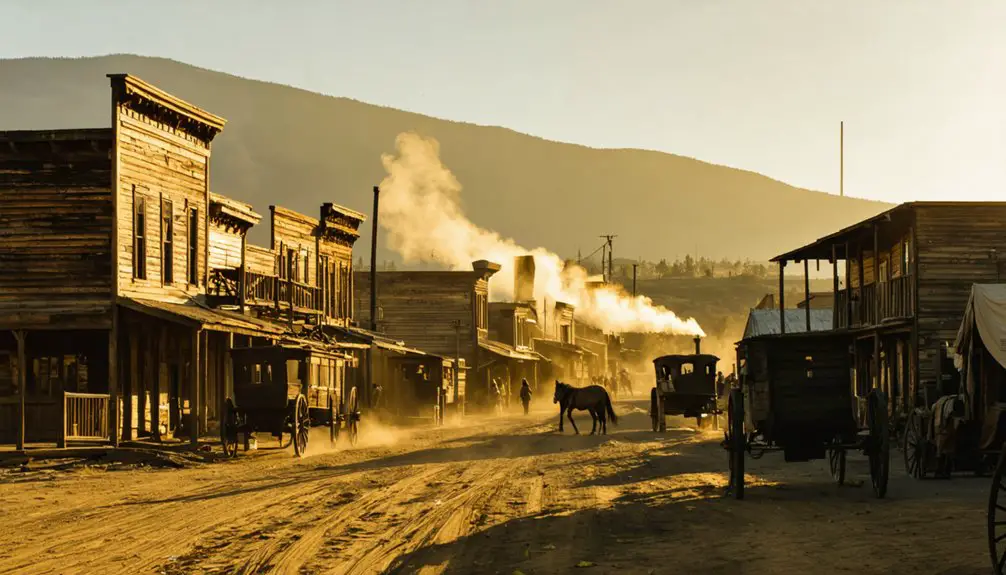
When silver ore discoveries in Nevada’s Arabia, Dun Glen, and Lima mining districts demanded processing facilities in 1865, Etna emerged as a strategic milling settlement on the eastern banks of the Humboldt River.
You’d have found two bustling mills employing crucial milling techniques to process the steady stream of silver ore from nearby camps. The settlement, sometimes called Aetnaville, quickly grew to meet the region’s ore processing needs. Like the gold fever that swept through Nevada in the 1860s, silver mining brought hopeful prospectors to the area. The ten-stamp Etna Mill faced a temporary shutdown in 1866.
As mining activity intensified, the settlement’s growth accelerated. George Lovelock established the Big Meadows Hotel, while other entrepreneurs opened a general store and livery stable.
A ferry service across the Humboldt River connected Etna to essential transportation routes, transforming this once-empty riverbank into a self-sufficient frontier community.
Life at the Crossroads of Silver Mining
You’ll find evidence of intense mill work in Etna’s remains, where laborers once toiled at the ten-stamp mill processing silver ore from nearby camps like Arabia and Dun Glen.
In the late 1890s, high-grade gold veins would be discovered in the area, leading to the establishment of new mining operations.
The town’s economic fortunes rose quickly in 1865 as two mills, including the Chrysopolis, served the surrounding mining districts and supported a growing community with a hotel, store, and ferry service.
Like many settlements in the region, Etna emerged during the silver mining boom that transformed Nevada from a territory into a state.
Mill Workers’ Daily Struggles
Life in Etna’s milling settlement tested workers’ resilience daily as they processed silver ore from nearby mines starting in 1865. You’d find workers shouldering long shifts at the Chrysopolis and Etna Mills, battling dust, noise, and dangerous machinery while handling toxic mercury in the amalgamation process. The harsh conditions were reminiscent of those faced by workers at Mount Etna’s slopes.
Worker camaraderie formed at the Big Meadows Hotel, where you could swap stories and find brief respite from the harsh conditions. When mill output dwindled, some workers sought opportunities in the Comstock Lode district, which had transformed Virginia City into a bustling mining hub.
Your daily challenges included unreliable pay, primitive living conditions, and limited access to medical care. The isolation meant you’d depend on basic services from the general store and post office, while fighting winter’s grip and flooding near the Humboldt River.
When mills closed intermittently due to competition, you’d face tough choices about relocating to survive.
Economic Rise and Fall
Founded in 1865, Etna emerged as a bustling silver milling settlement that would experience both dramatic growth and swift decline.
You’d have witnessed the town’s rapid expansion as economic cycles drove the establishment of crucial services, including:
- Two productive silver ore mills anchoring the local economy
- A general store, livery stable, and surveyor’s office serving daily needs
- A ferry service connecting trade across the Humboldt River
Like Silver Peak’s 10 stamp mill in 1865, Etna’s mining infrastructure represented significant investment in the region’s silver potential.
The promise of silver riches proved short-lived, though. By 1866, mining technologies couldn’t sustain profitable ore extraction, leading one mill to relocate while the other struggled with sporadic operation. This struggle mirrored the broader challenge of surface silver depletion that plagued many Nevada mining operations of the era.
The town’s fate reflected Nevada’s broader silver boom-bust pattern – when surface deposits depleted, costly underground mining drove away investment and workers.
The Mills That Built Etna
The mills of Etna represented the heart and soul of this Nevada boomtown, established in 1865 to process silver ore from the nearby mining camps of Arabia, Dun Glen, and Lima.
You’ll find the original mills were positioned strategically on the Humboldt River’s eastern bank, initially powered by expensive steam boilers.
As competition intensified, milling innovations emerged. In 1870, Midian Torrey transformed the Etna Mill by installing an undershot water power wheel, harnessing the river’s flow for more economical operations.
Despite these adaptations, the mills couldn’t overcome mounting challenges. Antimony fumes sickened workers, ore quality diminished, and rival camps like Oreana drew business away. At its peak, the town supported a population of 500 residents who relied on the mills for their livelihood.
Daily Operations and Economic Activities
During its brief heyday from 1865 to 1872, Etna’s daily operations revolved around a bustling network of crucial services supporting the town’s primary milling industry.
Etna’s short-lived prosperity centered on an intricate web of vital services that kept its silver milling operations alive.
You’d find mining logistics seamlessly integrated through the ferry service across the Humboldt River and the livery stable’s transport operations. Community services expanded quickly to meet the needs of workers and residents. Similar to the Treasure Hill mines, silver production was the economic foundation until operations ceased.
Here’s what kept Etna’s economic engine running:
- The general store served as a crucial hub for supplies and goods
- A surveyor’s office managed mining claims and town planning
- Mills processed silver ore while Chinese laborers contributed to the workforce
Despite these operations, Etna’s economy couldn’t diversify beyond its dependence on silver processing.
When the mills began closing after 1866, the town’s fate was sealed.
Environmental Challenges and Health Concerns
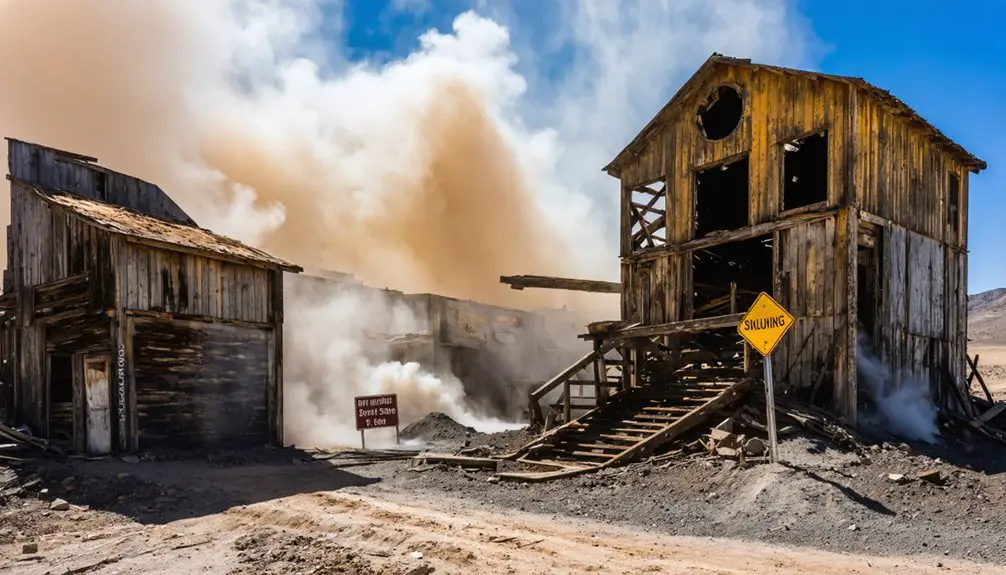
If you’d visited Etna’s mining operations in the 1860s, you’d have encountered toxic antimony fumes from the ore processing mills that caused severe respiratory illnesses among workers.
The harsh desert climate compounded these health risks, as extreme temperatures and limited ventilation trapped dangerous chemicals in the workplace.
These environmental hazards, combined with inadequate protective equipment, contributed greatly to Etna’s eventual abandonment by 1872.
Antimony Exposure Impact
Mining operations at Etna left a complex environmental legacy of antimony contamination that continues to impact the region today. When you explore this ghost town, you’ll find yourself walking through an area where historic milling activities released harmful antimony compounds into the soil, water, and air.
The contamination poses ongoing health risks to visitors and local ecosystems.
Here’s what makes Etna’s antimony exposure particularly concerning:
- The toxins persist in soil and sediments, spreading through erosion and runoff
- Workers in the 1860s-1870s suffered severe respiratory issues from antimony fumes
- The contamination often combines with other dangerous metals like mercury and lead
You’ll need to exercise caution when visiting, as the site requires careful monitoring and cleanup efforts to protect both human health and the surrounding environment.
Harsh Climate Effects
Beyond the antimony hazards, Etna’s harsh climate presents its own set of challenges for visitors and former inhabitants alike.
You’ll face extreme temperature swings, with scorching days reaching 93°F and nights plummeting below freezing. The arid environment, averaging just 24 inches of annual precipitation, demands careful climate adaptation strategies for survival.
Wind-driven dust storms and sporadic thunderstorms compound these challenges, accelerating the decay of historic structures while creating treacherous conditions.
You’re exposed to serious health risks, from heat exhaustion during peak temperatures to hypothermia on frigid nights. The low humidity and dusty conditions can trigger respiratory issues, while sudden weather changes stress both body and shelter.
These environmental extremes played a vital role in shaping life in Etna and continue to impact preservation efforts today.
The Brief Post Office Era
Although Etna’s prosperity proved short-lived, the town’s brief postal era began in July 1866 when officials established a post office to serve the bustling milling community.
The postal significance extended beyond basic mail delivery, creating crucial community connections through:
- Support for commercial operations, including ore shipping transactions and mill communications
- Service to travelers using the Humboldt River ferry crossing
- Integration with other essential town services like the general store and surveyor’s office
You’ll find it telling that by October 1866, just three months after opening, the post office closed its doors.
This rapid shutdown mirrored the town’s declining fortunes, as competing milling camps drew business away and local mills ceased operations.
The post office’s brief existence perfectly captures Etna’s dramatic rise and fall as a frontier boomtown.
Decline and Abandonment
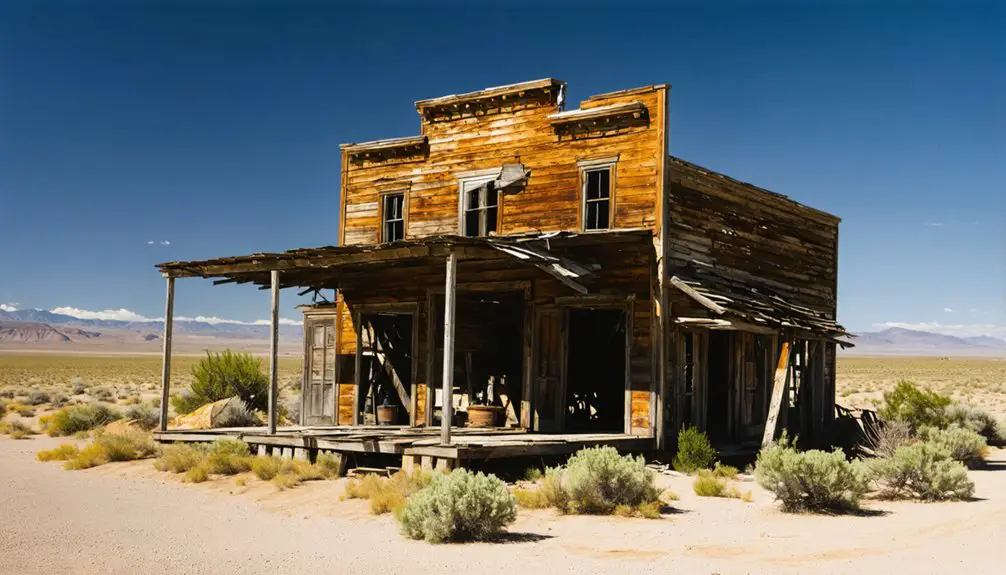
Despite early promise, Etna’s decline began swiftly in 1866 when its two foundational mills faced critical setbacks. One mill was dismantled and moved, while the other temporarily closed.
Though Midian Torrey attempted to revive operations in 1870 by switching to an undershot water wheel, the town couldn’t overcome its mounting challenges.
Torrey’s desperate shift to an undershot wheel in 1870 proved futile against Etna’s inevitable decline and mounting operational difficulties.
You’ll find resource depletion was the primary culprit – as rich ore veins ran dry, extraction costs soared while profits plummeted.
The town’s remote location, far from the railroad, made operations increasingly costly. Toxic antimony fumes and harsh working conditions drove away laborers, accelerating the population decline.
Legacy in Pershing County
While Etna’s physical structures have largely vanished, its legacy endures as a demonstration of Pershing County’s dynamic mining history.
As one of the region’s notable ghost towns, Etna exemplifies the boom-and-bust cycle that characterized Nevada’s 1860s silver rush. You’ll find its mining legacy preserved through historical records and the stories of industrial innovation that once drove the local economy.
- The town’s strategic position along the Humboldt River influenced regional mining logistics.
- Etna’s mills, particularly the Etna Mill and Chrysopolis Mill, pioneered silver processing techniques.
- The town’s transformation from a bustling mining hub to a ghost town mirrors the broader pattern of resource-dependent settlements throughout Pershing County.
Distinguishing Between Nevada’s Two Etnas
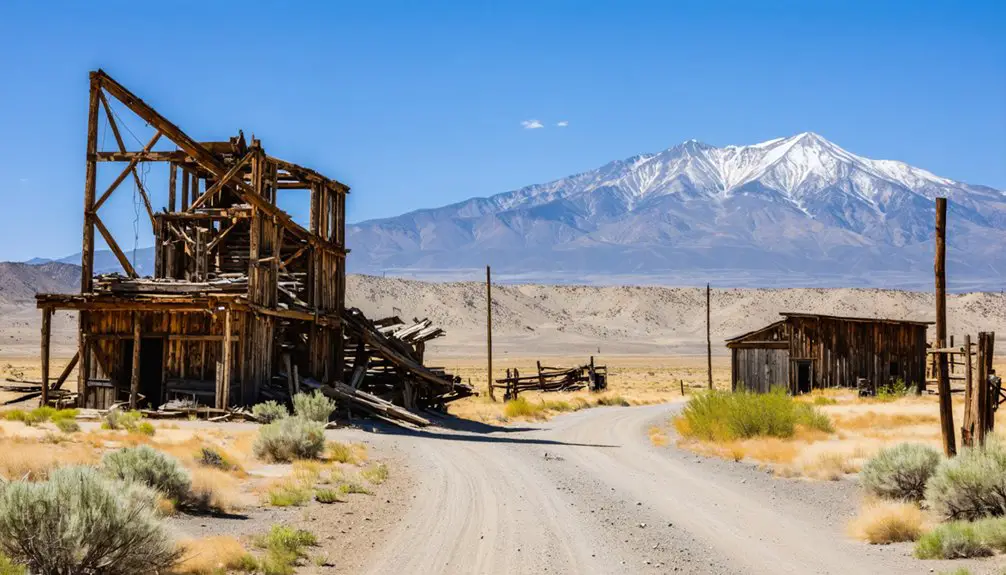
Because Nevada contains two distinct ghost towns named Etna, understanding their unique characteristics helps prevent confusion among historians and explorers.
You’ll find Pershing County’s Etna near the Humboldt River, where it thrived briefly as a silver milling town in the 1860s before its quick abandonment in 1872. In contrast, Lincoln County’s Etna, located 130 miles southeast, served as a railroad station and ranch settlement until the late 1970s.
The Etnas comparison reveals striking differences in their historical significance. While Pershing County’s Etna represents Nevada’s boom-and-bust mining era with its mills, stores, and ferry service, Lincoln County’s version tells a story of sustained rural development through ranching.
You’ll also discover unique cultural features, like the prehistoric Etna Cave near the Lincoln County site, while Pershing County’s legacy remains purely industrial.
Frequently Asked Questions
What Happened to the Original Buildings and Structures After Etna Was Abandoned?
You’ll find no historical preservation happened – the buildings experienced natural deterioration, material scavenging, and weathering until they vanished completely, leaving only archaeological remains to mark their existence.
Were There Any Notable Crimes or Lawlessness Incidents in Etna?
You won’t find specific documented crime incidents from Etna, though its minimal law enforcement and boomtown nature suggests typical mining town lawlessness like saloon fights and property disputes likely occurred there.
What Was the Highest Recorded Population of Etna During Its Peak?
Like a fading photograph, Etna’s exact peak population wasn’t recorded. You’ll find historical clues suggesting several hundred residents at most during 1865-1866, when the town’s mills were bustling with activity.
Did Any Significant Historical Figures Visit or Conduct Business in Etna?
You won’t find records of any famous visitors or significant business dealings in Etna. The short-lived mill town’s remote location and brief existence kept it off the radar of notable historical figures.
Are There Any Remaining Artifacts or Ruins Visible at the Site Today?
Like scattered breadcrumbs from the past, you’ll find remnants of mining structures, cabin foundations, and historical artifacts dotting the landscape. Rock art panels and deteriorating tools tell stories of ancient civilizations.
References
- https://en.wikipedia.org/wiki/Etna
- https://www.nvexpeditions.com/pershing/etna.php
- https://nevadamagazine.com/issue/winter-2024-2025/25048/
- https://nvtami.com/2022/11/13/humboldt-pershing-county-ghost-towns/
- https://www.wikiwand.com/en/articles/Etna
- https://nevadamagazine.com/issue/july-august-2014/7049/
- https://westernmininghistory.com/towns/nevada/oreana/
- https://www.us-data.org/nv/tw/esmeralda/
- https://www.visualcapitalist.com/sp/nevada-silver-districts/
- https://goldspringsresource.com/projects/history/
